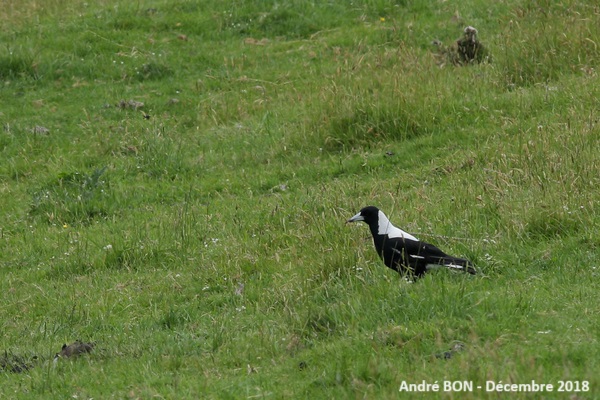
| Australian Magpie (Gymnorhina tibicen (Latham, 1802)) |

|
|
Scientific name: Gymnorhina tibicen (Latham, 1802) Common name: Australian Magpie French name: Cassican flûteur Order: Passeriformes Family: Artamidae Size: Body size: 38 to 44 cm; Weight: 220 to 350 g; Wingspan: 64 to 85 cm. Habitat: Open environments near trees for nesting, meadows, cultivated areas, parks and gardens. Missing in desert areas and dense forests. Food: The Australian Magpie feeds on the ground, on small invertebrates, small insects, larvae, small lizards, amphibians and also seeds and fruits. Nesting: The nest, built by the female, is a cup of small branches lined with finer plants. It is usually located on a fork quite high in a tree. There are two to five eggs per clutch. Males sometimes attack passers-by, pedestrians or cyclists, who pass near the nest. Migration: Sedentary. Geographic area: Australia, southern New Guinea, Tasmania, introduced to New Zealand and the Fiji Islands. |
The Australian Magpie is a bird with shiny black and white plumage and a melodious song. The nape, shoulders and top of the tail except for a terminal stripe are white. The beak is strong and pointed. It is light blue in colour with a dark grey tip. The wings are quite short. The long legs are black. Adults' eyes are red. Females are similar to males but the white areas have some grey, particularly on the nape. There are nine subspecies which differ in overall size, bill length and back colour. These subspecies are often classified into two groups, the Black-backed Australian Magpies and the White-backed Australian Magpies. |
| [To know more about the Australian Magpie] [Top] |

|
I observed this Australian Magpie on the heights of Akaroa near Long Bay Road, at the start of a short hike in the Banks Peninsula. Unless I'm mistaken, the very white nape of the neck must indicate a male. |